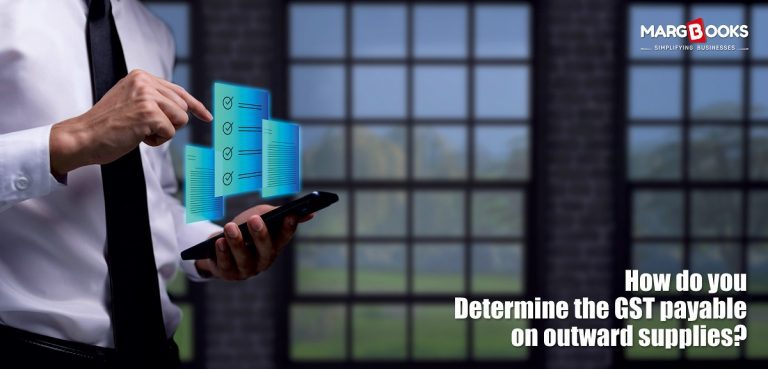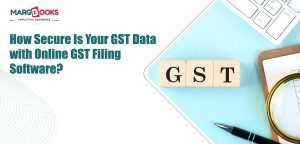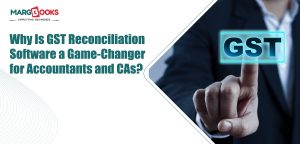In India, Goods and Services Tax (GST) has revolutionized the taxation system, simplifying the process of collecting and remitting tax on goods and services. Understanding how to determine the GST payable on outward supplies is crucial for businesses to ensure compliance with GST regulations and avoid penalties.
In this blog, we will break down the process in a comprehensive manner, covering everything from the basics of GST payable to how to leverage accounting software and online GST software to make this process more efficient.
What is GST Payable?
GST payable refers to the amount of Goods and Services Tax that a business needs to pay to the government on the outward supply of goods and services. Outward supplies refer to the sale or transfer of goods or services by a business to a customer. GST applies to all types of outward supplies, including sales, export of goods, and provision of services.
Under the GST regime, the tax structure is divided into three main categories:
- CGST (Central GST) – Collected by the central government
- SGST (State GST) – Collected by the state government
- IGST (Integrated GST) – Collected on interstate supplies (when goods or services are moved between states)
Why is Determining GST Payable Important?
Determining the correct GST payable ensures that your business remains compliant with the law. Paying the right amount of tax on outward supplies also avoids unnecessary fines, penalties, and legal complications. Additionally, understanding the tax liabilities helps businesses maintain accurate financial records and optimize their GST returns.
How to Calculate GST Payable on Outward Supplies?
To calculate the GST payable on outward supplies, several factors need to be considered. The process typically involves the following steps:
1. Identify the Type of Supply
The first step in determining the GST payable is identifying the type of supply you’re making:
- Intra-state supply: When the goods or services are sold within the same state.
- Inter-state supply: When the goods or services are sold to a customer in a different state.
- Export: Supplies made to foreign countries are generally exempt from GST or subject to zero-rated GST.
2. Determine the GST Rate
GST rates are classified into different slabs, depending on the type of goods or services. Common GST rates include:
- 0% GST: Applicable to essential goods such as food grains, fresh fruits, and vegetables.
- 5%, 12%, 18%, 28%: Applied to various goods and services depending on the industry and the nature of the product or service.
The GST rate applicable to the product or service will be the determining factor for calculating the amount of tax payable. You can find the GST rate applicable to specific goods and services in the GST rate schedule published by the Government of India.
3. Calculate the Value of Supply
The value of supply refers to the price at which the goods or services are sold, excluding taxes. To calculate the GST payable, multiply the value of the supply by the applicable GST rate.
Formula:
GST Payable=Value of Supply×GST Rate\text{GST Payable} = \text{Value of Supply} \times \text{GST Rate}GST Payable=Value of Supply×GST Rate
For example, if a product is sold for ₹10,000 and the applicable GST rate is 18%, the GST payable would be:
10,000×18%=₹1,80010,000 \times 18\% = ₹1,80010,000×18%=₹1,800
4. Adjust for Input Tax Credit (ITC)
Businesses can claim an Input Tax Credit (ITC) on the GST paid on their purchases (input supplies). This credit can be used to offset the GST payable on outward supplies. The net GST payable is the difference between the total GST on sales (output tax) and the total GST on purchases (input tax).
Net GST Payable=Output GST−Input GST (ITC)\text{Net GST Payable} = \text{Output GST} – \text{Input GST (ITC)}Net GST Payable=Output GST−Input GST (ITC)
For example, if your total output GST is ₹5,000, and you have an input GST of ₹2,000, the net GST payable would be:
5,000−2,000=₹3,0005,000 – 2,000 = ₹3,0005,000−2,000=₹3,000
5. Report and File GST Returns
Once the GST payable has been determined, the next step is to report and file the GST returns. GST returns must be filed monthly or quarterly, depending on the business turnover. These returns include details of sales, purchases, and the amount of GST payable. Failure to file returns on time can result in penalties.
The GST returns typically include:
- GSTR-1: Outward supplies (sales) details.
- GSTR-3B: Summary of outward and inward supplies, and the tax payable.
- GSTR-9: Annual return.
Leveraging Accounting Software and Online GST Software
With the increasing complexity of GST compliance, businesses are turning to technology to simplify the process. Accounting software and online GST software can significantly streamline GST calculations, returns filing, and overall tax management.
Benefits of Using Accounting Software:
- Real-time Calculation: Accounting software automatically calculates GST payable based on the sales and purchases recorded.
- Easy GST Filing: Software can directly integrate with GSTN (GST Network) for hassle-free filing of GST returns like GSTR-1 and GSTR-3B.
- Error Reduction: Reduces human errors in calculating GST payable, preventing mistakes that could lead to penalties.
- Automated Updates: Ensures compliance with the latest GST rates and law amendments.
Benefits of Online GST Software:
- User-Friendly Interface: Most online GST software is designed to be intuitive, allowing even small business owners with limited accounting knowledge to use it.
- Cloud-Based: Access your data from anywhere, ensuring that your GST records are always up-to-date.
- GST Analytics: Provides detailed reports and analytics to help businesses track their GST liabilities and credits.
One such example of online GST software is MargBooks. MargBooks simplifies GST management with its user-friendly interface, enabling businesses to quickly calculate their GST payable, file returns, and keep track of tax liabilities with minimal effort.
Conclusion
Determining the GST payable on outward supplies is essential for every business in India to maintain compliance with the tax system. By understanding the correct procedure and using accounting software or online GST software like MargBooks, businesses can make this process smoother and more efficient. Remember, accurate GST calculations and timely filing are key to avoiding penalties and ensuring your business operates smoothly under the GST regime.
Whether you are a small business owner or running a large enterprise, embracing technology to manage your GST obligations will save you time, effort, and money. Always stay informed about the latest GST updates to make sure your business remains compliant and optimized for success.




